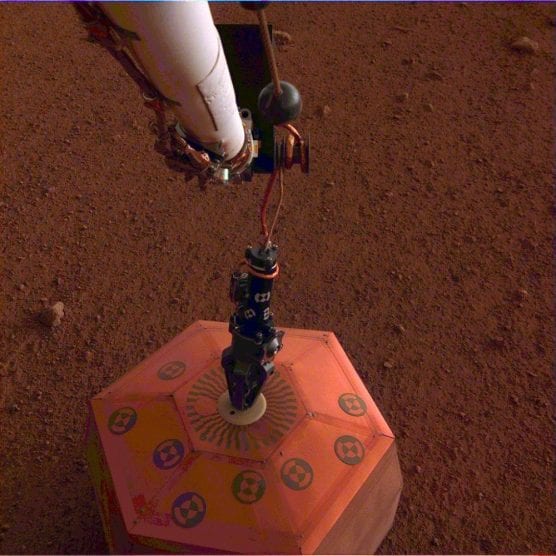By Martin Macias Jr.
The NASA InSight spacecraft designed to study the depths of the Martian surface placed its first instrument on the red planet Wednesday, completing a major milestone in a mission that aims to gain insight into the origins of our universe.
With Canyon Country residents Scott Evans and Gene Bonfiglio among the key NASA-JPL engineers guiding the mission, the aptly named InSight lander touched down on Mars on Nov. 26 after a six-month, 300 million-mile journey from its launch at Vandenberg Air Force Base in California in May.
Images received Thursday by NASA scientists show InSight’s seismometer on the ground, faintly illuminated in the Martian dusk.
In a statement Thursday, scientists at NASA’s Jet Propulsion Laboratory in Pasadena, California, who are managing the InSight project, celebrated the news.
“InSight’s timetable of activities on Mars has gone better than we hoped,” project manager Tom Hoffman said. “Getting the seismometer safely on the ground is an awesome Christmas present.”
NASA expects the copper-colored instrument, which measures seismic waves called marsquakes, will provide new information on how all celestial bodies with rocky surfaces, including Earth and the moon, first formed.
To deploy the seismometer, NASA engineers first had to be sure the robotic arm that picks up and places InSight’s instruments onto the Martian surface was working properly. Engineers did that by testing commands for the lander using an identical robot placed on a bed of crushed rocks modeled after the Martian surface.
Scientists also analyzed images of the Martian terrain around the lander to figure out the best places to deploy the instruments.
After testing and image analysis, engineers sent final commands on Tuesday from Earth to the InSight lander. On Wednesday, the commands were received and InSight gently placed the seismometer onto the ground.
NASA’s Bruce Banerdt said in the statement that placing the seismometer onto the Martian surface is the “highest priority” for the InSight mission.
“Seismometer deployment is as important as landing InSight on Mars,” Banerdt said. “We need it in order to complete about three-quarters of our science objectives.”
NASA engineers are focusing on getting the first bits of seismic data back from the Martian surface and leveling out the seismometer, which is sitting on ground that is tilted 2 to 3 degrees.
The seismometer will measures marsquakes, which NASA said are events that act as a kind of flashbulb illuminating the structure of the planet’s interior. By analyzing how seismic waves pass through the layers of the red planet, scientists can get a better sense of the depth and composition of the planet’s layers.
“Having the seismometer on the ground is like holding a phone up to your ear,” said Institut de Physique du Globe de Paris’ Philippe Lognonné, an engineer with the project.
In early January, engineers expect to command InSight’s robotic arm to place a wind and heat shield over the seismometer to stabilize the environment around its sensors. A separate heat probe instrument is expected to be placed onto the surface in late January.
Meanwhile, the project’s Rotation and Interior Structure Experiment, which does not have its own separate instrument, has already begun using InSight’s radio connection with Earth to collect preliminary data on the planet’s core.
NASA said InSight will operate on the surface for one Martian year plus 40 Martian days, or sols, until Nov. 24, 2020.
Like this:
Like Loading...
Related





 Tweet This
Tweet This Facebook
Facebook Digg This
Digg This Bookmark
Bookmark Stumble
Stumble RSS
RSS


























REAL NAMES ONLY: All posters must use their real individual or business name. This applies equally to Twitter account holders who use a nickname.
1 Comment
Sounds amazing . How soon till be can send every Liberal there to live